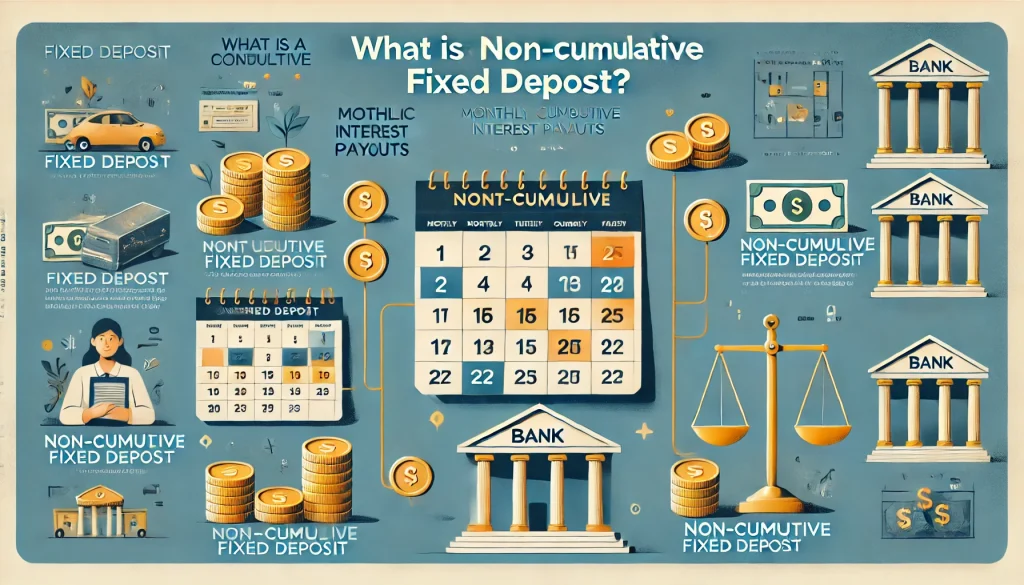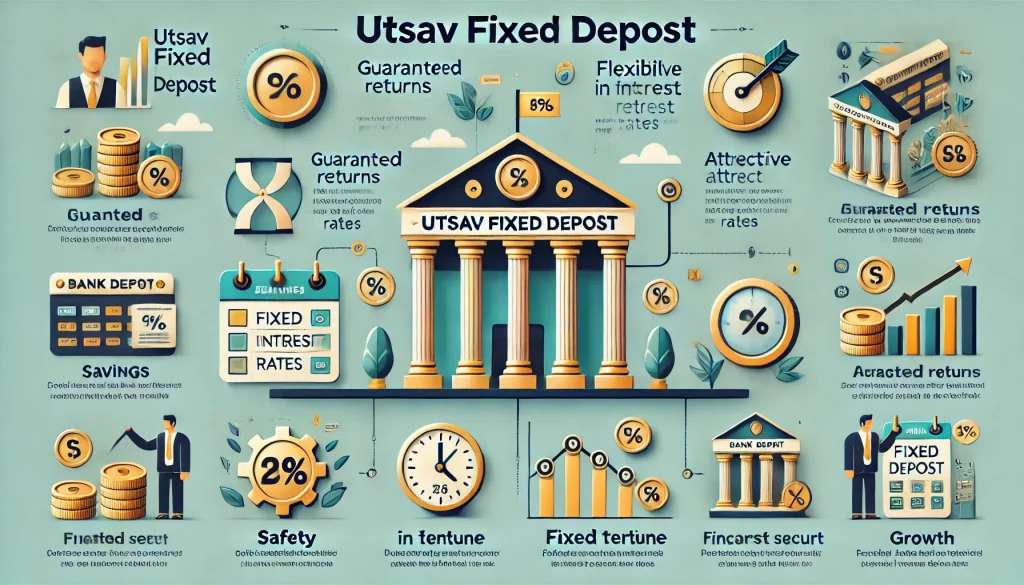
Did you know that if you invest ₹1 lakh annually in a non-cumulative fixed deposit account for 5 consecutive years at 9.25% p.a., your investment will mature to ₹1,46,250?
Given the above scenario, the maturity sum for the same ₹1 lakh investment will be ₹1,44,500, ₹1,44,750 or ₹1,45,250, if your FD provider calculates interest monthly, quarterly or half-yearly respectively. Thus, it is evident that your returns are computed and even paid out periodically in a non-cumulative FD account. To know more about this category of fixed deposit schemes, continue reading.
What Is a Non-Cumulative Fixed Deposit?
Unlike traditional fixed deposit schemes that provide returns upon maturity, non-cumulative fixed deposit accounts guarantee regular payouts. Being an investor, you can choose whether you would prefer to receive interest payments on an annual, half-yearly, quarterly or monthly basis. However, note that you will need to fix this preference when opening your fixed deposit account.
Typically, the tenure for non-cumulative fixed deposit accounts ranges between 12-60 months. Financial advisors often suggest these schemes to freelancers, retirees, housemakers and other individuals who usually look for a regular and predictable passive income source.
Key Features to Look Out for in Non-Cumulative Fixed Deposits
Non-cumulative FDs have multiple unique features that make them even more desirable for regular income seekers. Some of them include:
- Constant Interest Rate
Throughout the investment period, you get a consistent interest percentage on your non-cumulative FD investments. It gives you a sense of certainty regarding your annual earnings.
- Payouts at Regular Intervals
It is the most preliminary feature of non-cumulative fixed deposit accounts that makes it different from other FDs. Investors can specify their preferences for periodic payouts which allow them to generate a steady passive income avenue throughout their investment tenure.
- Wide Range of Tenure Options
You can explore non-cumulative FDs with tenures ranging between a few months to several years. Thanks to the vast range of options, you can pick a time frame that complements your liquidity needs and financial goals.
- Simple Interest Calculation
You get simple interest returns on non-cumulative fixed deposit schemes which can be effortlessly calculated beforehand using an online simple interest calculator. This boosts income predictability and helps plan your expenses accordingly.
Benefits of Investing in Non-Cumulative FDs
You can enjoy the following advantages upon opening a non-cumulative FD:
- Regular Income Stream
The non-cumulative fixed deposit will guarantee a regular and predictable income making life convenient for those who rely on such payouts. Hence, the potential beneficiaries can be retired professionals as well as those having an irregular income.
- Desired Liquidity
You get periodic payouts at your preferred frequency which resolves liquidity issues. With monthly/quarterly/half-yearly payments, you can meet your running financial obligations and also manage daily expenses without needing to withdraw the invested amount.
- Low-risk Investment
Non-cumulative fixed deposit accounts are backed by deposit insurance and are most of the time offered by reputed banks and NBFCs. Thus, you can rely on their credibility.
For added security, you may opt for FD accounts that are listed on the Stable Money app. These schemes are backed by DICGC, a direct subsidiary owned by the Reserve Bank of India.
- Effective Tax Planning
Your earnings from a non-cumulative FD are taxed in the same financial year they are credited to your account. This is beneficial for tax planning as it allows you to spread your overall tax liability over multiple years.
Eligibility Criteria for Opening a Non-Cumulative Fixed Deposit
While opening a non-cumulative fixed deposit, the same rules apply as in the case of a regular FD.
Any Indian citizen residing in the country, as well as Non-resident Indians (NRIs) and Hindu Undivided Families (HUFs), are allowed to open a non-cumulative FD. However, specific providers and financial institutions may establish their own set of criteria.
Returns on Non-Cumulative Fixed Deposits
While calculating the returns from non-cumulative FDs, you have to consider the following aspects:
- Interest Rate
The respective bank or financial institution determines the interest rate to be provided based on your fixed deposit tenure and the principal invested. Generally, these rates are highly competitive to attract more bank customers. You can compare them online on Stable Money to get the best possible deal.
- Payout Frequency
Although the returns more or less stay unaffected by the frequency of payouts, they influence your overall cash flow. For instance, if you avail a monthly payout, you will have more cash flow as compared to someone who opts for half-yearly payments.
Calculation of Returns on Non-Cumulative Fixed Deposits
To better understand the returns, you must take a look at a quick example. Suppose, Ms XYZ invests ₹50,000 in a non-cumulative fixed deposit and opts for quarterly payouts over one year. The bank offers her an interest rate of 6.5% per annum.
In this case, she is entitled to receive an overall annual interest payout of ₹3,250.
Here’s how the calculation takes place:
Ms XYZ’s quarterly interest = Principal invested * Quarterly interest
= ₹50,000 * (6.5/4)%
= ₹50,000 * 1.625%
= ₹812.50
It means she will receive ₹812.50 every quarter. Similarly, to calculate her annual interest earnings, we simply need to multiply the quarterly returns by 4. Likewise, Ms XYZ’s annual interest earning is ₹3,250.
Additionally, her principal amount of ₹50,000 remains intact. She can either reinvest or withdraw this amount after the non-cumulative FD tenure expires, i.e., one year after the account is opened.
Final Word
Non-cumulative fixed deposit account is a reliable option for anyone who is seeking to create a regular income stream. These schemes can give you stability and highly competitive returns over a period of several years. For more information, check out the available options on the Stable Money app and determine which particular plan aligns with your financial growth strategy.
Frequently Asked Questions
Yes, most FD providers, including both NBFCs and banks, charge penalties on premature fixed deposit withdrawals. Generally, they impose a rate of 0.5%-1% on the interest amount gained throughout the invested period. However, this rule can vary depending on the financial institution you choose.
In non-cumulative FDs, your interest returns are paid out periodically (monthly/quarterly/half-yearly/yearly). On the other hand, cumulative fixed deposits only provide a single payout at maturity where the payment includes an interest amount that has been compounded annually.
Non-cumulative FDs are specifically tailored for individuals who want to guarantee a regular source of passive income. These may include retirees, housemakers, students or even freelancers. Additionally, as the returns are not linked to market conditions, they are ideal for investors carrying a risk-averse approach towards investments.


